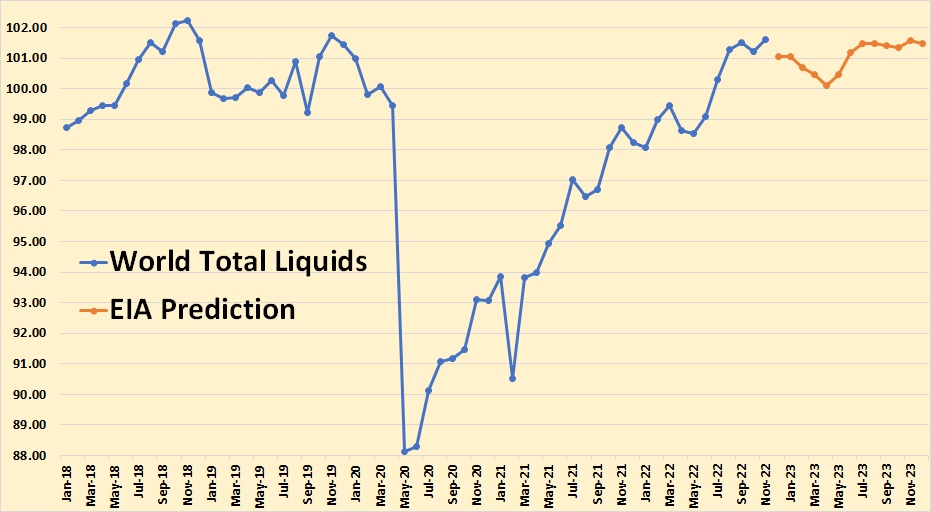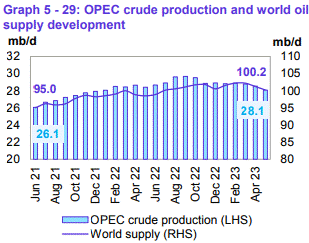(This blogpost can very well be read to the sound of the beautiful song "Silence must be heard" by Enigma)
In
this recent Youtube chat video that Ukrainian-Canadian hippie and peakoiler Andrii Zvorygin had with
Steve St. Angelo (from the blog "SrsRocco Report", one of the most educated peakoilers out there) and some others, 36 minutes into the video, I found some very important and seldom mentioned data (which is almost impossible to find on the internet, so bad is the education level there [1], although this is about the most important data we can get) by Steve St. Angelo about the decline of global conventional crude oil (minus condensate) since 2006. Here are the most important data:
In 2006, at the peak of it, we had 70,3 mbd of conventional crude oil (minus condensate) production.
In 2016, we had 69,6 mbd.
In 2019 we had 66,5 mbd.
In 2022 we had 63,5 mbd.
Let's calculate the decline between 2006-2022 (in the end of this year, 2022, oil production had pretty much recovered from the sharp decline during the peak of the pandemic, from 88 mbd in May 2020, up to 101,6 mbd in November 2022, see the chart in [2] and [3]):
I divide the period 2006-2022 into two periods of 8 years (this, periods of 8 years, was also essential to
my book 2023 about global oil exports). In 2014, at half the time into this age, the level of conventional crude oil minus condensate was at about the same level as in 2016, at 69,6 mbd.
1) 2006-2014: From 70,3-69,6. A decline of 0,7 mbd, or 1 % for the whole period, on average ~0,09 mbd per year, which is 90 000 mbd per year.
2) 2014-2022: From 69,6-63,5. A decline of 6,1 mbd, or ~8,7 % for the whole period, on average 0,76 mbd per year. So in 2022 we lost at least 760 000 barrels of conventional crude minus condensate in only one year!! Probably as much as 1 mbd!! So fast the decline goes nowadays! And it is even worse now!!!
Then to the future projection. 8,7 is 8,7 times 1. So in the second period above, the oil decline was 8,7 times faster than in the first period. So this means that in the third period,
3) 2022-2030, the decline, if it follows the trend, will accelerate 8,7 times the decline in 2). Remember that we are late in the decline period 2006-2030, and when something declines exponentially, i.e. with an accelerated rate, which global conventional crude oil (minus condensate) does right now, the decline is really, really fast in the end, and catches one with surprise (I have to concede that I have trouble believing in my own calculations in this blogpost). Remember that in the previous periods, civilization was not in collapse (and anyway the decline soon got steep), which it is now and will continue to be in the 3) period, which makes the decline very, very steep. If the decline could accelerate 8,7 times between 2006 and 2022, what then when civilization and the oil industry goes into its collapse phase, which accelerates exponentially, i.e. at an accelerated rate of decline?
8,7 X 6,1 mbd is ~53 mbd. 63,5-53 mbd is 10,5 mbd. So in 2030 we have 10,5 mbd of global conventional crude oil minus condensate left. 53 mbd in 8 years, it's on average a ~6,6 mbd annual decline. In the end of the 2022-2030 period the decline rate is above 10 mbd a year, which is the natural decline rate of the global oil production today, according to Steve St. Angelo (more exactly 10,5 %). And in that year 2030 the decline goes so fast that we lose all the remaining oil reserves in one year, so it all ends in 2031.
If the global conventional crude oil minus condensate production reaches its terminal end in 2031, one could assume that global conventional crude oil minus condensate exports reaches its end way before that, perhaps in 2027, at the earliest. Because the decline rate of global oil exports is much higher than that of overall global conventional oil (minus condensate) production, and falls at an accelerated rate of decline. This again confirms my calculations in my book about global oil exports.
P.S.: Andrii Zvorygin has a very remarkable graph (which I think he has made together with John Peach) in the video chat above, 1.14.04 into the video, about the remaining oil reserves, where he shows that we have only 5-16 years of conventional oil reserves left (2PCS). 8,55 years of 1P (proven) reserves, and 8,41 years of 2P (probable) reserves.
This 5 year figure is the most radical I have heard of, and it really makes me lyrical and hopeful.
[1] Try to do a
research on images for charts on the global conventional crude oil minus condensate, and you will find tons of meaningless, totally irrelevant and
stupid information, most of it very, very outdated. Information that seldom in any way help us to prepare for the END. So bad the search engines are, still. And so stupid the peak oil community was and is. You don't, for example, find very much useful information on the end of global oil exports.
[2]





